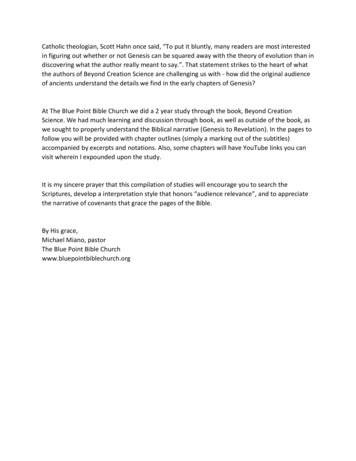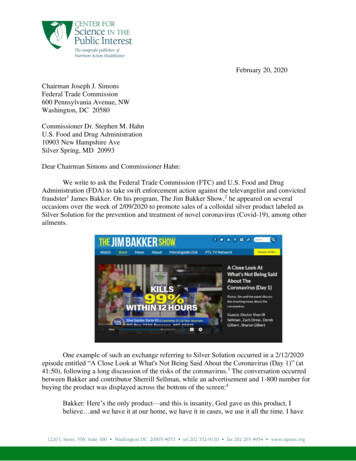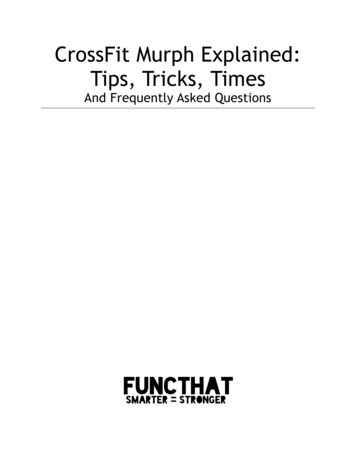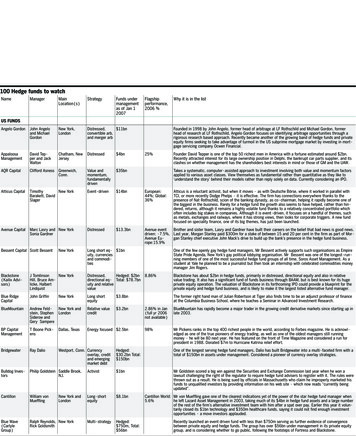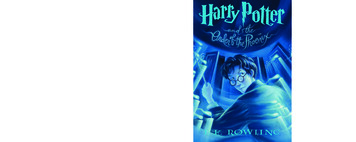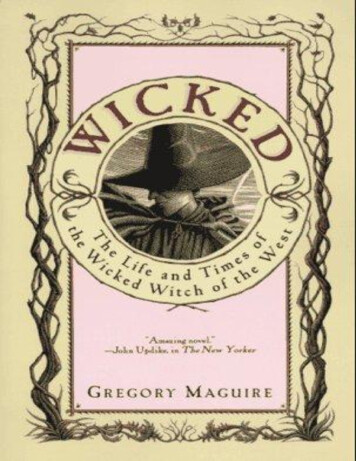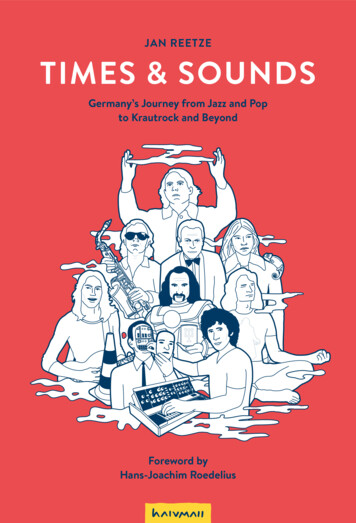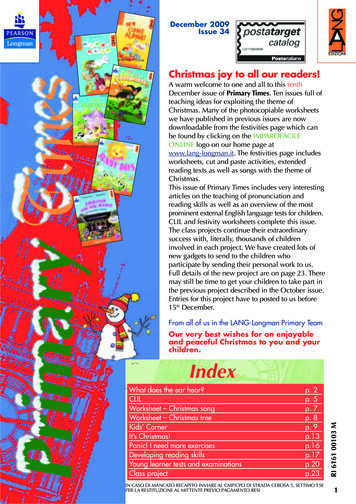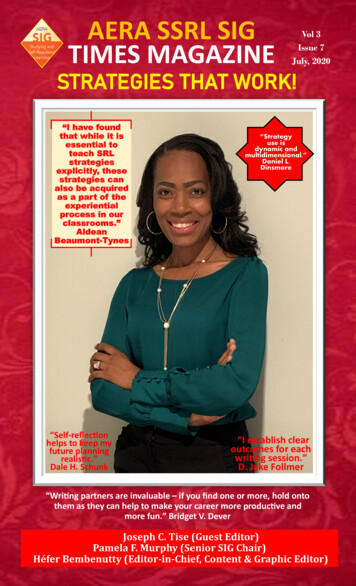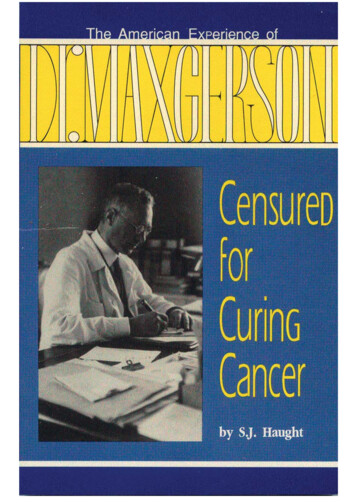
Transcription
My editor had ok'd the story, "The Unveiling of a Quack,"and now I faced the man whom the power of the press wouldsquash like a bug."Five times," he said in response to my question, "theMedical Society of the County of New York sent a committeehere to investigate my methods. I let them see patients,X-rays, records, everything.""And what were the results of those investigations?""I do not know," Dr. Gerson replied. "They have neverrevealed them."I left Dr. Gerson and wrote the Medical Society of theCounty of New York, as follows: "We have no feeling oneway or the other concerning Dr. Gerson's treatment exceptthat of public responsibility. Is there any way we can beadvised of the nature of your findings?"Their reply was to embark me on the strangest, mostfrustrating story of my life. the story of a man who byabsolute record had cured people of cancer, includingchildren, and his incredibly courageous and lonely fightagainst the forces of organized medicine.— S.J. Haught
S.J. HaughtP.U.L.S.E
Published by The Gerson Institute, P.O. Box 430, Bonita, California 92002 in associationwith Station Hill Press, Inc. (under the P.U.L.S.E. imprint), Barrytown, New York, NewYork 12507.Distributed to the trade by The Talman Company, 150 Fifth Avenue, New York, New York10011. .Original Copyright 1962 by London Press. Copyright transferred to Gerson Institute in1983.Second Edition, edited by Gar Hildenbrand, Copyright 1991 by the Gerson Institute. Allrights reserved.The photograph of Claude Pepper from Eyewitness to a Century, Copyright 1987 byClaude Pepper, is reprinted by permission of Harcourt Brace Jovanovich, Inc.The photograph of Raymond Gram Swing from "Those Radio Commentators!" by IrvingE. Fang,is reprinted by permission of Iowa State University Press.Cover design by Christeene Hildenbrand.No portion of this book may be reproduced in any form without permission in writing fromthe publisher, except by reviewers who may quote brief passages as part of their reviews.Library of Congress Cataloging-in-Publication DataHaught, S. J.[Cancer? Think curable! The Gerson therapy]Censured for curing cancer: the American experience of Dr.Max Gerson / S.J. Haught.p. cm.Reprint. Originally published: Cancer? Think curable! TheGerson therapy. Bonita, Calif.: Gerson Institute. 1962.ISBN 0-882768-109-51. Gerson, Max. 2. Cancer—Diet therapy. 3. Diet therapy.L Title.RC271.D52G475 1991616.99 '40654—dc2091 -10382CIPManufactured in the United States of America.
"Stay close to nature,and its eternal laws will protect you."— Dr. Gerson, to his daughter
AcknowledgementsOur thanks to Chip White for his invaluableassistance in entering the text of this bookfor the current edition.Thanks to Michael Jablonski for helpingmultiple computers and programs interactcooperatively, and for producing the layout.
ForewordI was perplexed when I learned that medical historian Dr. PatriciaSpain Ward's "History of the Gerson Therapy" had been withheldfrom us. After all, we were the advisory panel. Each of us had beenappointed by the U.S. Office of Technology Assessment (OTA) toserve as expert outside advisors to a study of "UnconventionalCancer Treatments". Yesterday, the second panel meeting had comeand gone with no mention of it. Now it was Friday, July 29, 1988.As executive director of the Gerson Institute, I was annoyed atOTA project director Hellen Gelband. Dr. Ward had delivered thecontract report to OTA a month ago. It was my field of expertise.Why hadn't I been allowed to see it?I walked to the OTA offices at 600 Pennsylvania Ave. from thenearby Capital Hill Hotel, rehearsing possible confrontations in mymind. When I got there, Julie Ostrowsky told me that I could not evensee the report. My jaw went slack and my pulse intensified. She saidthat she and Hellen had read it and incorporated it into the study draft,and that was "the same thing" as letting the advisors read andcomment on it. My jaw came up into a spring steel clench of teeth."Where's Gelband? I want to talk to her," I growled.I was already disappointed in Gelband's overall performance. Istill couldn't imagine why she was so nervous about letting me haveWard's paper. Ward had written "Who will bell the cat?" quite a fewyears earlier, an article critical of Dr. Andrew Ivy whose reputationdisintegrated because of his advocacy of the unconventional cancerdrug Krebiozen. In fact, I figured that paper was the reason Gelbandhad hired her. I expected from Ward similar views on Gerson. Afterall, Gerson had been the target of the same tough American MedicalAssociation (AMA) trade boycotts that ruined Ivy, and there was lotsof bad propaganda about him in the Journal of the AMA and other
copycat trade magazines. But I wanted to see the Gerson contractreport, even if it was negative, as a matter of principle.Gelband came out with the paper in her hand. She gave it to me,saying that I couldn't take it with me, that I couldn't have a copy,and that I would have to read it right there. I was too astonished toargue. She showed me into her office where she ate lunch and chattedon the phone while I read.The first sentence of Ward's report took me entirely by surprise,and by the close of the first paragraph I knew I was reading the workof an enlightened and literary historian. I remember clearly theheightening sensation as I read:It is one of the least edifying facts of recent American medical historythat the profession's leadership so long rejected as quackish the idea thatnutrition affects health (JAMA 1946,1949, 1977; Shimkin, 1976). Ignoring both the empirical dietary wisdom that pervaded western medicinefrom the pre-Christian Hippocratic era until the late nineteenth centuryand a persuasive body of modern research in nutritional biochemistry, thepolitically minded spokesmen of organized medicine in the U.S.remained long committed to surgery and radiation as the sole acceptabletreatments for cancer. This commitment persisted, even after soundepidemiological data showed that early detection and removal of malignant tumors did not "cure" most kinds of cancer (Crile, 1956; updated byCairns, 1985).The historical record shows that progress lagged especially in cancerimmunotherapy — including nutrition and hyperthermia — becausepower over professional affiliation and publication (and hence overpractice and research) rested with men who were neither scholars norpractitioners nor researchers themselves, and who were often unequippedto grasp the rapidly evolving complexities of the sciences underlying midtwentieth-century medicine.Nowhere is this maladaption of professional structure to medicine'schanging scientific content more tragically illustrated than in theAmerican experience of Max B. Gerson (1881-1959) [emphasis not inoriginal], founder of the best-known nutritional treatment for cancer ofthe pre-macrobiotic era.A scholar's scholar and a superlative observer of clinical phenomena,Gerson was a product of the German medical education which Americansin the late 19th and early 20th centuries considered so superior to our ownthat all who could afford it went to Germany to perfect their training. Asa medical graduate of the University of Freiburg in 1909, Gerson imbibedall of the latest in scientific medicine, with the emphasis on specificitywhich bacteriology had brought into western medical thought in thepreceding decades. Gerson subsequently worked with leading Germanspecialists in internal medicine, in physiological chemistry, and in neurology.
With the sort of horsecrap Gelband was passing off in the OTAstudy draft as a biographical sketch of Dr. Gerson, her attempt toconceal Ward's paper now needed no explanation. The AMA boycottof Gerson was alive and well thirty years after his death. S.J.Haught's book is a vital and topically important account of thedestruction of Gerson's reputation by the retrograde leaders of theAMA of his time. It clearly documents deceit and damaging actionsof both the AMA and the American Cancer Society (ACS) againstGerson, and against any people with cancer he might have but,because of AMA and ACS, could not help.In the thirty years since this book was written, the cancer epidemichas grown steadily to become a bloated, devouring monster. Today,more than six million Americans have cancer. This year alone, onemillion and ten thousand Americans will be told, "I'm sorry, it'smalignant, you have cancer." This year, at the rate of one per minute,more than half a million Americans will die of cancer. And yet, theboycott continues.In Haught's book are documented the seeds of today's low levelof discourse in U.S. cancer medicine, especially nutritional oncology. The propaganda campaigns continue, with the American CancerSociety in the lead, and poorly informed smaller groups such as theNational Council Against Health Fraud tagging along.Haught provides enough information to clear the air, which is stillmightily polluted. Today's readers will be grateful to him for having, done his job so well thirty years ago.Gar HildenbrandExecutive DirectorThe Gerson InstituteBonita, CaliforniaJanuary, 1991
11A change in the weather seems to have a strange effect on somepeople. I don't suppose I was the first reporter to have noticed it, butlet the weather turn suddenly warm and you can expect a rash ofletters and phone calls from readers who want to air their grievancesor complain about some personal persecution. Newspapers oftenrefer to these folks as the "lunatic fringe."But more than once among those relaters of incredible stories Ihave found a genuine case of injustice. A newspaper, I felt, shouldbe the last hope and refuge for bewildered souls who have beenbuffeted and torn by a world that can be harsh and cynical, who havebeen elbowed out of the way by insolent officials and exploited byunscrupulous schemers, and who don't know where else to turn. Anewspaper should be more than comic strips and puzzles; it shouldbe the conscience of society.Today the sun was shining. After weeks of bitter cold and slush,New York had turned unseasonably warm. Topcoats disappearedfrom the streets and office workers crossed Third Avenue in theirshirts to pick up containers of coffee from the little delicatessens.A number of letters awaited me at my desk that morning — a noteof thanks from a singer I'd written a feature story about; a letter froma woman in upstate New York who wanted more information on aplastic surgeon I'd written about, and a three-page typewritten letterthat began:
2"To Whom it May Concern:"My name is, I'm 28 years old and a mother of a seven-yearold daughter. I'm writing my story in hope that it will help others andto help me receive financial aid. On May 28th, 1957 I was operatedon atHospital for a blood-vessel tumor located in the abdomen.It was the size of a grapefruit and extended into both hips. Five dayslater they started me on deep X-ray therapy. Three weeks later thetumor was back again. Then three months later, even though I hadbeen receiving deep therapy consisting of 47 treatments at 15minutes each, the tumor was as large as it had been before theoperation. I'd like to add that these treatments had left me badlyburned across the stomach and the lower part of the back. Now thisoperation and all these X-ray treatments did me absolutely no good,and left me 1,100 in debt, as I was just as bad as I had been in thebeginning."The doctors that I had gave me only from two to six months tolive starting from the time of the operation, which, however, I didnot know at this time. After the 47 treatments, I was given a monthoff from therapy. It was at this time that Mrs.a friend of mine,told me about her mother who had lymphosarcoma and went to Dr.Gerson three years ago. She is completely cured now."On Sept. 18, 1957,1 went to see Dr.for my checkup andsuspecting that I had cancer, since I had all the symptoms, I askedhim directly if it was. He told me 'Oh, don't be silly.' Then I askedhim if there was anything besides therapy that I could use and hereplied 'No, there was only therapy and I had to have it for a longtime.'"On Sept. 19,1957,1 went to see Dr. Max Gerson of Park Avenue,New York City. He examined me and informed me that the tumorwas back and was a large mass and that I definitely did have cancer.He admitted me to his 'Oakland Manor Cancer Clinic' in Nanuet,New York, on Sept. 23, 1957. He has discovered the cause of canceras well as the cure, the cure being a corrective diet along with certainmedications. Five days after I was on the diet at his clinic, as God ismy witness, the tumor shrank to the size of a golf ball and two monthslater had completely disappeared. Even though these X-ray treatments left me approximately 90% sterile at that time, Dr. Gerson saysthat in two years time I can have a completely normal child. Everything Dr. Gerson told me would happen did come true, so that I'm
3certain that what he said about my being able to have children willcome true, too, because I have already noticed signs of my reproductive organs returning to normal."I have been on this diet for five months now and I'm feeling fineand getting stronger every day, without the aid of any drugs. I amdoing light housework, my own cooking, and the laundry for myhusband and myself. I also have my daughter home on weekends.During the week she lives with my mother. I go to Dr. Gerson everymonth for a checkup and according to the physical examination andmetabolism test I'm improving rapidly."The diet consists of: orange juice, green juice, liver juice andcarrot juice. I take 12 glasses of juice every day made with a specialgrinder and press. I receive a B-12 shot with liver extract twice aweek, and two coffee enemas a day. My meals consist of fresh fruit,cottage cheese, skim milk, and yogurt. My diet costs over 50 aweek."My husband's income at the present time is 56 a week, takehome pay. My family has helped me as much as they can. Now thatthey can no longer help, it i
[Cancer? Think curable! The Gerson therapy] Censured for curing cancer: the American experience of Dr. Max Gerson / S.J. Haught. p.cm. Reprint. Originally published: Cancer? Think curable! The Gerson therapy. Bonita, Calif.: Gerson Institute. 1962. ISBN 0-882768-109-5 1. Gerson, Max. 2. Cancer—Diet therapy. 3. Diet therapy. L Title. RC271.D52G475 1991

